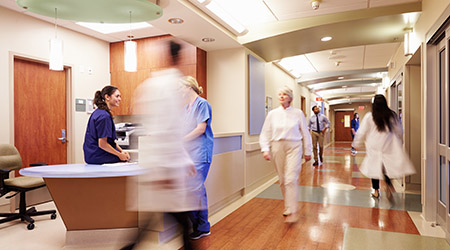Lighting control systems can produce up to 50 percent energy savings in hospitals and other healthcare facilities. But why don’t more facilities, especially existing buildings, use these products? Healthcare Facilities Today set out to answer this question through a roundtable with industry product manufacturers.
What are the hurdles preventing facility managers from incorporating lighting controls? How can managers overcome them?
Budget and coordination. Clients are not typically focused on the connection between lighting and patient care and can be quick to deprioritize these solutions. Learn how lighting controls impact patients and staff. Lay out what is needed in key spaces. And work with the design team to review the wide range of solutions available to meet project budgets and performance requirements.
Patient spaces have many interconnected systems and more integration requirements than a typical commercial project. To avoid project delays and frustration, it’s essential to think about how these systems will talk to one another and to identify who is responsible for getting them connected.
Timing is so important — the earlier you start, the easier it is. Make sure you understand the needs of the space and work closely with the lighting rep or manufacturer to determine both the right lighting control solution, and the budget necessary to meet your goals.
— Matt Ochs, Senior Director, Commercial Business, Lutron Electronics
One big challenge for lighting controls in today’s hospitals is the variety of space types typically found at a hospital. For example, you have patient rooms, nurse stations, operating rooms, cafeterias, and parking garages, just to name a few. Each space type is likely to have a different desired lighting control sequence that focuses on patient/worker comfort and safety in a variety of ways, while also ensuring that all building code requirements are met.
Meeting the needs of these space types becomes even more demanding when introducing another big challenge, which is a budget constraint. The best solution for hospitals is to specify a singular lighting control system to meet budget needs, one that is both flexible and scalable to meet the variety of control needs and building code requirements, while still providing that focus on patient/worker comfort and safety.
Like hospitals, off-campus healthcare facilities often see a similar challenge in the wide-variety of space types in the facility, each with different lighting control needs, while still working under budget constraints. Maintaining a single solution that can meet the needs of these space types, while still providing a focus on patient/worker comfort and safety, is critically important.
— Steve Roe, Vice President of Indoor Controls, Acuity Brands Lighting

 UF Health Hospitals Rely on Green Globes to Realize Their Full Potential
UF Health Hospitals Rely on Green Globes to Realize Their Full Potential How Healthcare Facilities Can Be Truly Disaster-Resilient
How Healthcare Facilities Can Be Truly Disaster-Resilient TriasMD Breaks Ground on DISC Surgery Center for San Fernando Valley
TriasMD Breaks Ground on DISC Surgery Center for San Fernando Valley Bigfork Valley Hospital Falls Victim to Data Breach
Bigfork Valley Hospital Falls Victim to Data Breach AI-Driven Facilities: Strategic Planning and Cost Management
AI-Driven Facilities: Strategic Planning and Cost Management